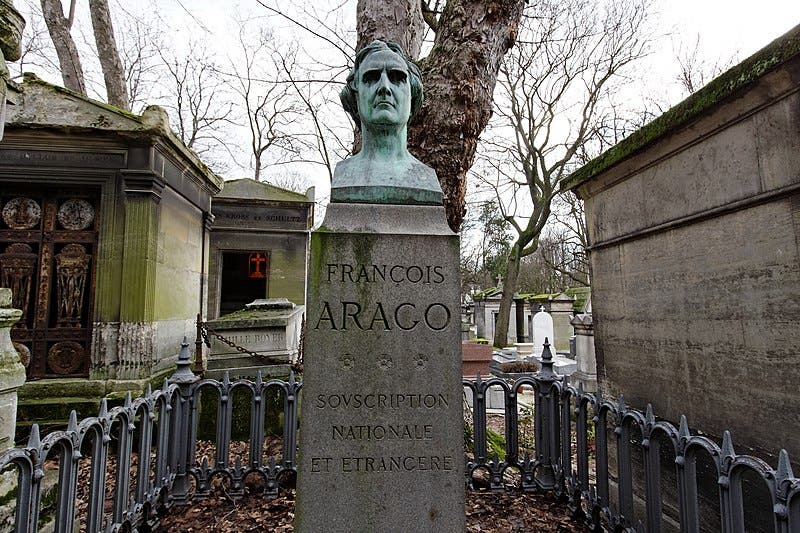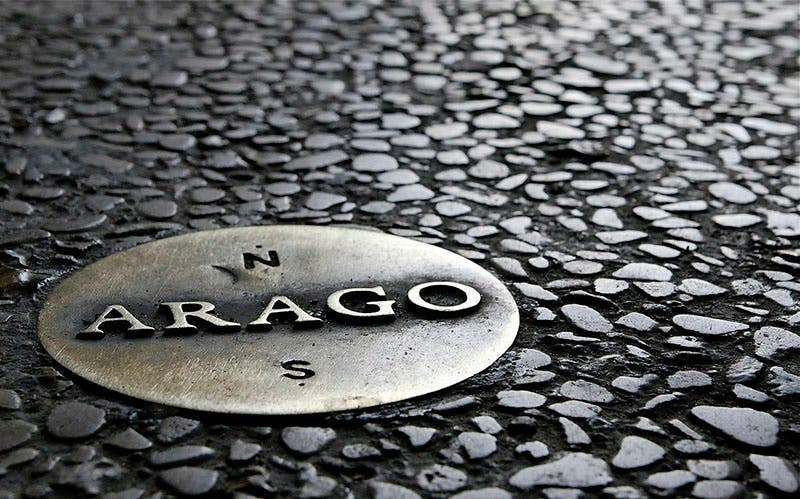Scientist of the Day - Francois Arago
François Arago, a French astronomer and homme politique, as the French call him, was born Feb. 26, 1768. Arago came from a town near the Pyrenees, but as a young man he made a trek to Toulouse to take the entrance exam to the prestigious Ecole Polytechnique in Paris, and he so distinguished himself that he gained admission. Upon graduation in 1806, he was appointed to a commission to extend the arc of the meridian south of France into Spain and the Mediterranean islands. We have mentioned meridian projects several times in this space (see, for example, our post on Jean Picard); for over a century, the French had been trying to lay out an accurate measurable line that passed north and south through Paris (the Paris meridian), for the purpose of: a) determining the length of one degree of a line of longitude at the latitude of Paris, and: b) knowing the size of a degree at different latitudes, trying to determine the shape of the earth (which seemed to be flattened at the poles). The latest project ended in 1804, with the death of Pierre Mechain, and Arago was appointed in his stead to go south into Iberia. However, about this time, Napoleon was ruffling his feathers in Spain, making being a Frenchman a dangerous occupation. Arago's surveying companion, Jean-Baptiste Biot, went home, but Arago plugged on, making a very accurate set of measurements, but before he could leave, he was arrested (this was in the summer of 1808), and for the next year, he spent time in various prisons; was twice given permission to board a ship bound for Marseilles, only to have his ships blown back to Africa, where he was arrested again; he would not see French soil again until 1809 and Paris until 1810. However, when he did make it back, with his precious notebook of measurements, he received a hero's welcome and was appointed to a position at the Paris Observatory, where he would work and live for the rest of his life.
Much of his later work was in optics, which is difficult to make interesting to a general audience, or even to myself. But Arago also took it upon himself to deliver lectures to the general public on astronomy, and he kept this up for 33 years, so he became a widely known and much beloved figure in Paris. He also served for many years as secretary to the Academy des Sciences, which was a powerful position, and it was in this capacity that Arago announced to the Academy, on Jan. 7, 1839, that Louis Daguerre had invented a method for recording a photographic image.
Arago wrote and published quite a bit. We have in the Library a 13-volume set of his complete works (1854-62) and a four-volume set of his Astronomie populaire (1854-57), plus a handful of translations into English. Since we cannot digitize everything at once, we start with volume one of his Astronomie populaire (second image), from which we chose a wood engraving of a Newtonian style telescope (it looks like the one with which William Herschel discovered Uranus; third image), and an engraved plate showing three nebulous objects as seen through a powerful telescope – that is the Great Nebula in Andromeda at the top (fourth image). There are many other attractive illustrations in this volume and the three others.
When Arago died in 1853, he was buried in Père Lachaise cemetery in Paris, which was founded while he was at the Ecole Polytechnique and eventually became THE place to be interred if you were anybody, especially after Abélard and Héloļse were reburied there in 1817. A bust of Arago stands over his remains, in a plot that is rather restricted by Père Lachaise standards (fifth image, just above). There is also an impressive statue of Arago in Perpignan, the town in the eastern Pyrenees where he grew up.
But my favorite monument to Arago is one that can easily be missed by a tourist on a walking tour of Paris – a series of 135 bronze medallions laid in the pavement along 5 miles of the Paris meridian as it passes through the city from south to north. Each medallion is about 5 inches across and each has Arago’s name in cast relief upon it. The project was the work of an artist, Jan Dibbets of the Netherlands, who deserves some sort of award for his sprawling work of subtle recognition. We see one of the 135 inlaid brass plaques in the image just above.
Dr. William B. Ashworth, Jr., Consultant for the History of Science, Linda Hall Library and Associate Professor emeritus, Department of History, University of Missouri-Kansas City. Comments or corrections are welcome; please direct to ashworthw@umkc.edu.








![“Aurora Borealis,” hand-colored wood engraving by Josiah Wood Whymper, [Natural Phenomena], plate 2, 1846 (Linda Hall Library)](https://assets-us-01.kc-usercontent.com:443/9dd25524-761a-000d-d79f-86a5086d4774/0245ffcb-b70c-477c-8792-0a73ebd54eb2/Whymper%2011.jpg?w=210&h=210&auto=format&fit=crop)


